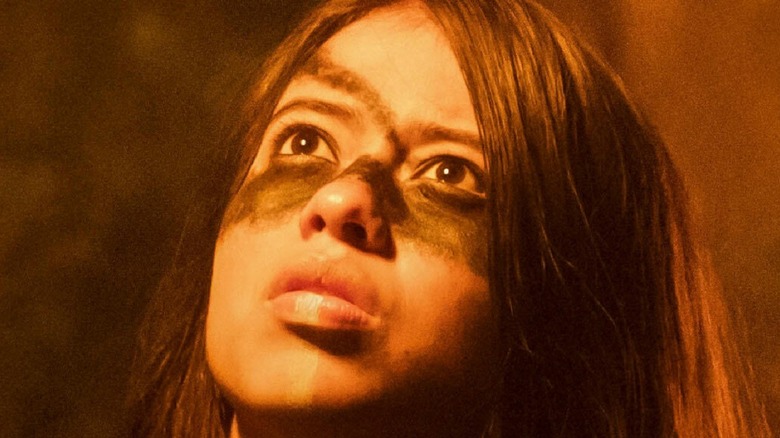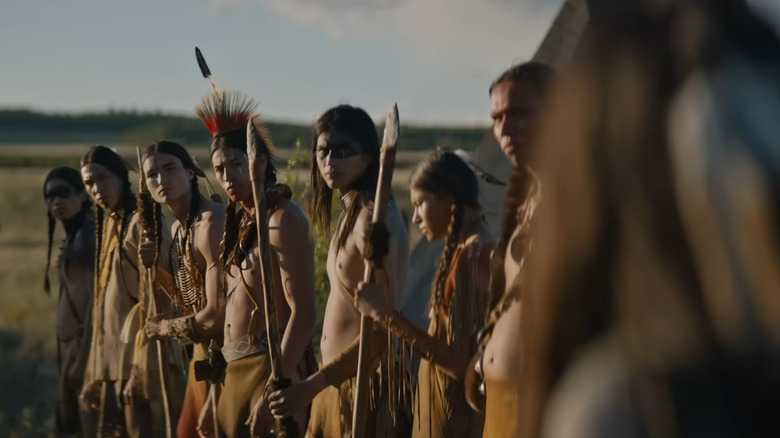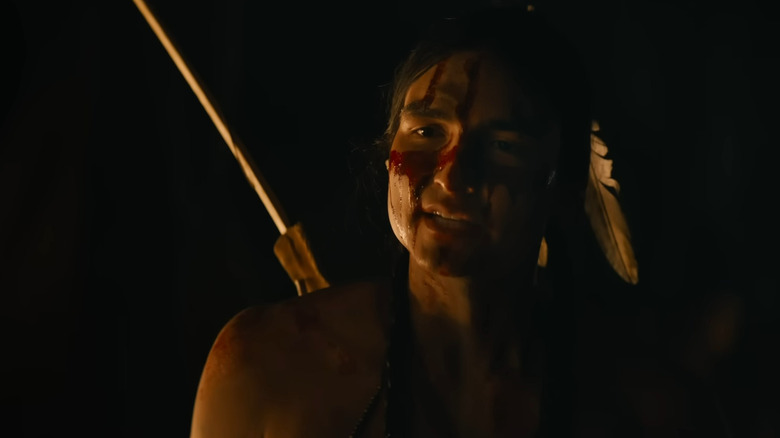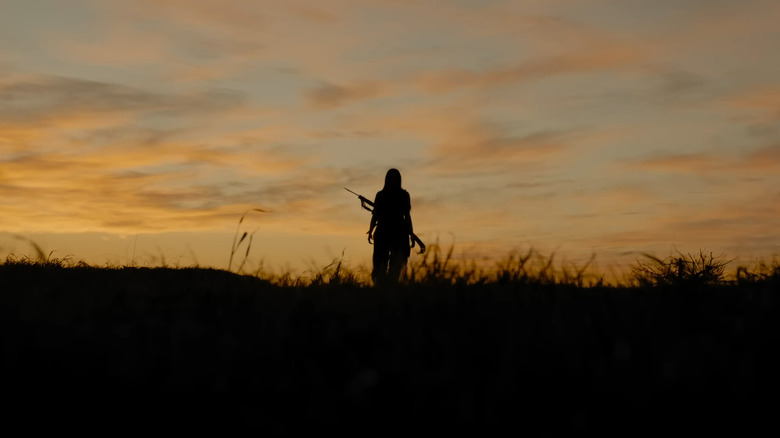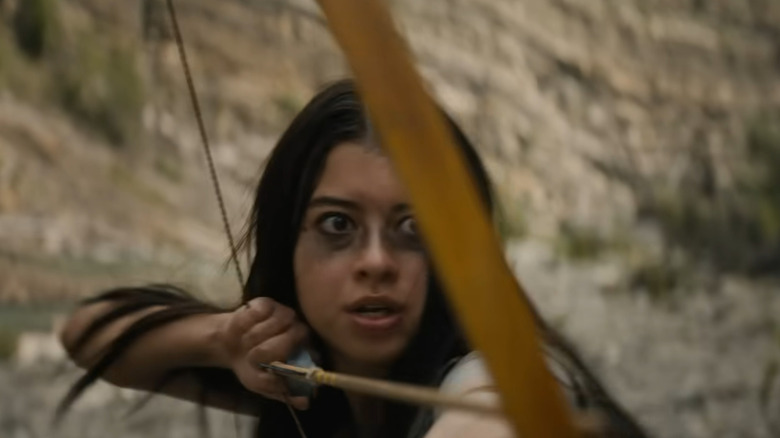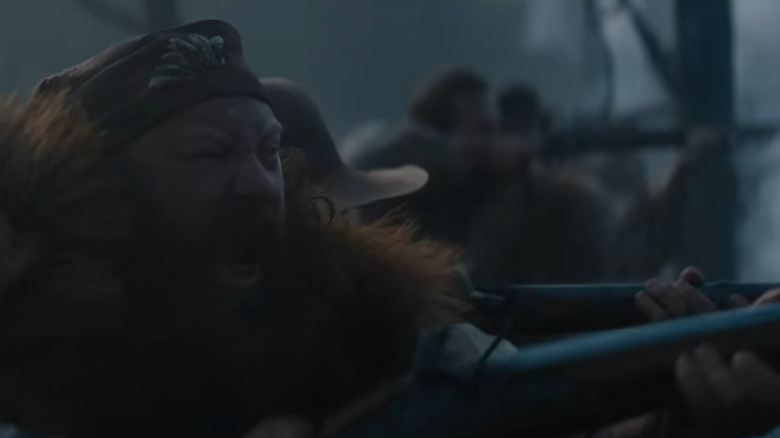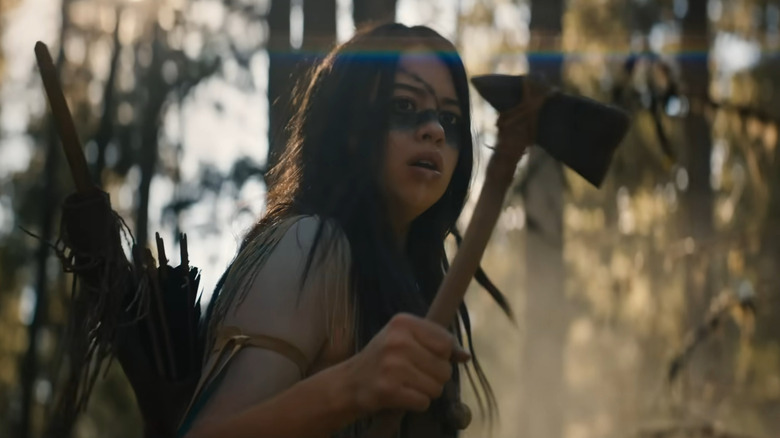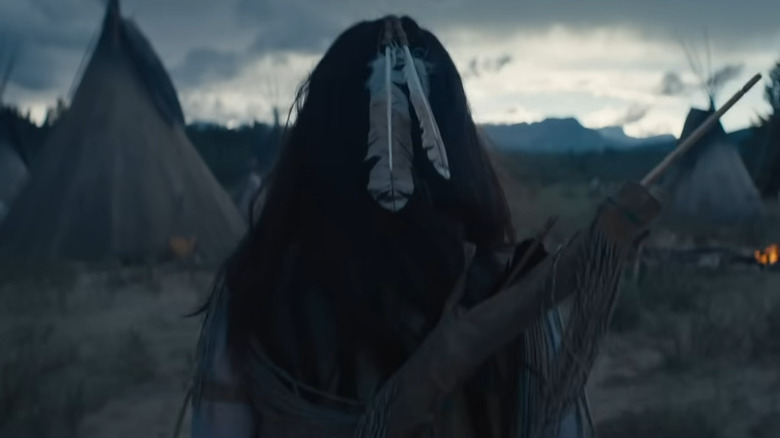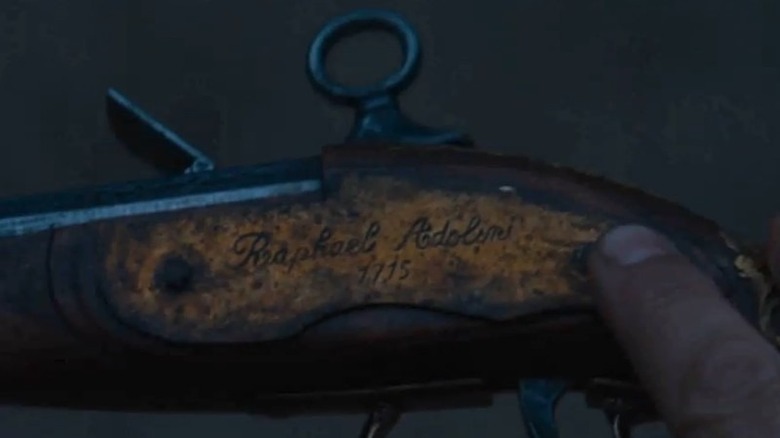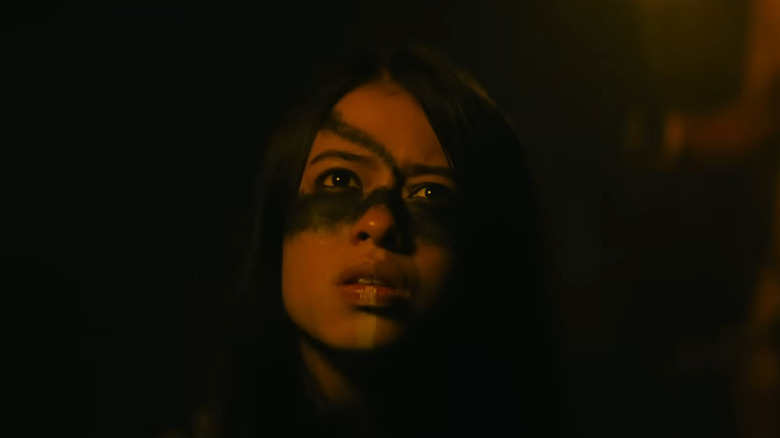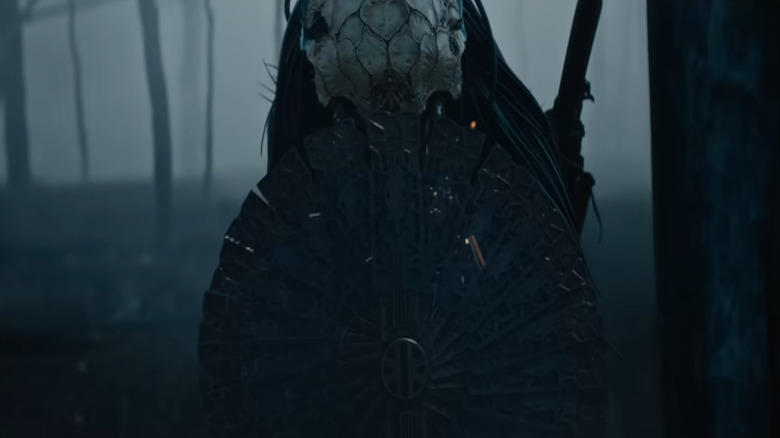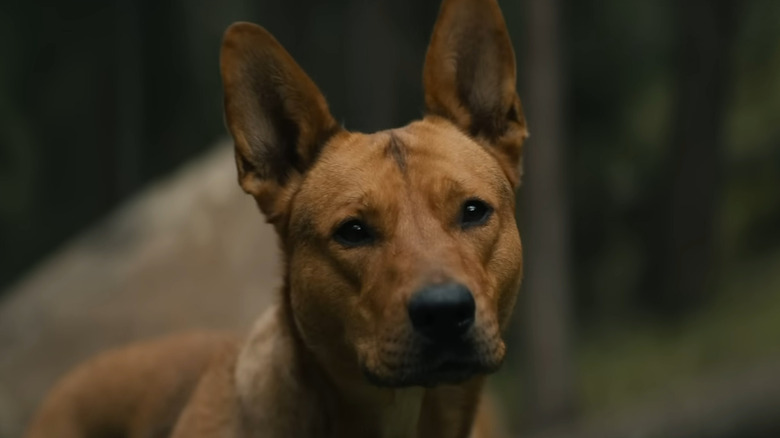The Ending Of Prey Explained
Though Hulu's "Prey" is the fifth mainline film in the "Predator" series, its story predates every one of its predecessors. Set in North America in 1719, the film follows a Comanche hunter named Naru (Amber Midthunder) who encounters the alien warrior while out scouting. Things take a violent turn when a group of European trappers and soldiers intrude, culminating in a climactic duel between Naru and the Yautja who's been tormenting her tribe.
From start to finish, "Prey" is filled with all the tense hunts and brutal action set pieces that fans have come to expect from the franchise. And because the film takes place so long before any other entry in the main series, it also makes some curious additions to the overall "Predator" lore. From the titular creature's interesting choice of weapons to the return of a particularly iconic flintlock pistol, there are a lot of little details in "Prey" that come together in the final act.
Of course, the climax of "Prey" also deals heavily with themes that are unique to it in the greater scope of the franchise — themes like coming of age, fighting for your role in society, and the importance of community. Here's everything you need to know about the ending of "Prey," how it connects to the previous "Predator" movies, and what the deeper themes mean.
It takes a village
Most "Predator" stories involve teams of commandos, criminals, or otherwise highly trained individuals facing off against the Yautja, usually with only one or two making it out alive. While many of the supporting characters in movies like "Predator" and "Predators" make valiant stands against the aliens, they almost always perish in the end. The same fate befalls many of the Comanche hunters in "Prey," but every member of the group plays a part in ultimately bringing the beast down.
With each encounter, Naru and the other members of her tribe learn more and more about the Predator. Observing when it does and doesn't kill clues her into the creature's thermal vision, the way its laser-guided weapon system works, the nature of its active camouflage, and its tendencies as a hunter. In this way, every Comanche character who dies to the beast contributes to its ultimate demise, imbuing Naru with the tools and knowledge she needs to, as her brother (Dakota Beavers) says, "bring it home."
This sacrificial group approach stands in stark contrast to the European faction in the film, who possess immense resources and more advanced weapons than the Comanches, but who seem incapable of learning from their failures in fighting the Yautja. Rather than adapt to the Predator's methods or strategize together in any meaningful way, they stubbornly employ the same stale tactics and put an unhealthy amount of trust in their guns, which ultimately fail.
Earning a brother's trust
Throughout "Prey," Naru's older brother Taabe shows himself to be a caring sibling who believes deeply in his sister but also desperately wants to protect her. At one point in the film, he tells Naru that he used her exact plan to kill the mountain lion they were hunting and that she successfully weakened it before falling unconscious and being carried back to the village. He clearly thinks that she's capable of becoming a great hunter, and he wants to build her confidence in a culture that discourages her hunting, but he also hesitates to send her into anything that's more than she can handle.
To be fair, Naru behaves in some pretty brash and bullheaded ways early on in "Prey." She goes off all on her own to hunt the Predator, albeit before fully understanding what she's up against. Through her encounters with the alien, however, she grows in both her courage and her cleverness, finally putting all the pieces together to become the hunter she's been trying to be for so long. In this way, her eventual victory over the Predator not only marks her as a respected protector of her people, but it also symbolizes the end of her own coming-of-age hunt — something she tells Taabe that she's ready for at the very beginning of the movie. If he could have lived to see her triumph, he surely would have been proud.
This is as far as I go
Sadly, Taabe becomes the final martyr in the Comanche's battle against the Predator. As he and Naru stand together searching for their invisible foe, Taabe realizes that he's the one the Yautja is after. "It thinks I'm the threat," he says somberly to his sister. "This is as far as I go. This is it. Bring it home." More than just a sacrifice, this moment shows that Naru has finally become a master hunter in her brother's eyes. He knows there's no way out for him, but he also seems completely confident that his sister will be able to do what the rest of their tribe could not.
When Naru does ultimately vanquish the Predator, she seems to have mixed feelings about the whole ordeal. There's a clear sense of pride at having defeated the beast that so many others fell to, but she also looks beaten down by the trauma and loss of the fight. At least she brings a bit of her brother into the final showdown with her, as she echoes his final words to the Yautja itself just before delivering the killing blow.
Outsmarting the Predator
After seeing the Predator kill so many others from her tribe and slaughter a small army of European trappers, Naru realizes that the only way to defeat the creature is to outsmart it. She captures the leader of the European group and uses him as live bait, but she cleverly allows him to get a weapon, making him look like more of a threat to the Predator and therefore drawing the alien out. Earlier in the film, she learns that the Yautja isn't interested in hunting prey that can't fight back, so she contrives the perfect scenario to lure the alien out of hiding. She also ingests some medicine to shield herself from the Predator's thermal vision — another strategy she picks up earlier in the film.
Once the alien reveals itself, Naru goes right to work. She uses a point-blank pistol shot to knock off the creature's helmet, which she promptly steals. After that, Naru lures the Predator back to a spot she knows well — a spot laden with deep, hidden mud pits. All these tactics — disarming the Predator's most dangerous weapons first, taking the fight to a familiar place, and playing on the creature's natural tendencies — show just how clever Naru is. She sees that brute force and fighting skills are useless against a foe as physically powerful as the Yautja. But in the end, she proves that being the strongest in a fight doesn't automatically make you the best hunter.
Technology is a fickle thing
The brutally clever killing blow that Naru delivers to the Predator in "Prey" drives home one of the film's recurring themes — the inefficacy of advanced technology in the face of superior intelligence and skill. Midway through the movie, Naru realizes that the Yautja's handheld spear gun is connected to the triangular targeting apparatus on the alien's helmet. In past "Predator" films, the red dots of the targeting device have typically heralded a blast from the iconic shoulder-mounted plasma cannon, but no such weapon appears in "Prey." That doesn't really end up mattering, though, as the homing spear gun winds up being just as deadly as any laser blast.
In the end, the Predator is killed by a shot from its own gun, as Naru sets up the targeting apparatus to aim at the creatures head. It doesn't recognize that the lasers have been activated, so when it fires a bolt at Naru, the Yautja is surprised to see the projectile loop back around to pierce its own skull.
Clearly, the homing device is a powerful weapon — as is the pistol Naru uses to dislodge it. And yet, these examples of more advanced technology both come with their share of caveats. The pistol jams and refuses to fire at different points, and the technological superiority of the Predator's gun ultimately becomes his undoing. By using these weapons as tools but never letting them supersede her natural talents (as the Europeans do), Naru shows that no technology is a replacement for training and intellect.
Naru the hunter
Despite numerous members of her tribe believing she's incapable of becoming a hunter (to the point that one of them engages her in a brutal slugfest midway through the movie), Naru proves herself by the time credits roll. She returns home covered in green alien blood and carrying the severed head of the Predator, which she deposits on the ground for all to see. The whole tribe begins to celebrate, mirroring the behavior seen when her brother returned earlier in the film with the body of the slain mountain lion. So has Naru finally been accepted as the skilled hunter she is? The film doesn't provide a concrete answer to that question, but it seems too be yes.
Regardless of how her friends, family, and peers view her, though, Naru is clearly changed by her experience. She's a proven warrior, yes — one of the only humans in all of history to have defeated a Yautja in combat — but she seems scarred by the experience as well. Maybe it's the loss of so many others along the way, including her brother. Maybe it's the realization that growing up and taking truly adult responsibility as a protector involves more exhaustion than glamor. Or maybe it's the fact that no dead Predator can stop the encroaching wave of European colonialists taking over the Comanche's land.
Moving to protected ground
While the Predator itself is a definite antagonist in "Prey," it's far from the film's only villain. The ecological and cultural war brought by white settlers is alluded to very early on in the film, when Naru's dog gets caught in a European trap. Like the Predator, the trappers are interlopers in a landscape that they don't fully respect or understand. And while they all get wiped out in "Prey," the early 18th century was only the start of a long process of land theft against the Comanches.
The primary method by which invading settlers dismantled Comanche rule of the southern Great Plains was the systematic eradication of the buffalo — the foundation for much of the Comanche lifestyle and economy (per the National Parks Service). By intentionally eliminating the animal from the North American ecosystem, white intruders were able to weaken the Comanche Nation through the 18th and 19th centuries. This eventual attack is alluded to early in "Prey" when Naru comes across a number of rotting Buffalo carcasses. The fact that the animals haven't been fully stripped for meat suggests that the Predator is responsible, but it's later revealed that the buffalo were actually killed by the white trappers.
After delivering the head of the Predator, Naru says that the tribe must move towards more "protected ground," as their current location isn't safe. Perhaps she anticipates the Comanche being blamed for the Yautja's European massacre, or maybe she simply wants to be prepared for their potential invaders. Either way, it's a pretty grim asterisk on what's otherwise a celebratory moment for Naru.
A strange gift
Along with the Predator's head, Naru presents the flintlock pistol she acquires as a gift to the elders of her tribe. When the chief inspects the gun, the camera shows an inscription that reads "Raphael Adolini," with the year "1715" written underneath. Dedicated fans of the "Predator" franchise will recognize this as an Easter egg, though the pistol's inclusion in "Prey" also brings up some interesting questions about the canonical "Predator" timeline.
At the end of "Predator 2," after making his way aboard the Yautja ship and meeting several of the species, Lieutenant Mike Harrigan (Danny Glover) is given the exact same flintlock pistol by none other than the leader of the Yautja hunting party. It seems to be a gift — a symbol of Harrigan's skill as a warrior — as the Predators then leave without killing the policeman. Because "Prey" takes place just four years after the inscription on the gun, it makes some sense why it would show up, but some things about its inclusion don't quite add up.
For starters, how do the Predators get the pistol back now that Naru has it? Is it sheer luck that, somewhere down the line, they kill a descendant of hers, or someone else who just inherited it? Or is the implication that the Yautja come back for Naru in particular, since she's proved herself to be a capable warrior? Either way, "Prey" seems to retcon the comic book "Predator: 1718," which relays a different account of the pistol's origin.
How the ending of Prey changes the Predator timeline
In the comic book "Predator: 1718," readers are introduced to pirate captain Raphael Adolini, who's searching for treasure off the coast of Papua New Guinea with his crew when they encounter a Predator. The alien eventually kills the whole pirate crew, including Adolini, but not before the captain gives the hunter his pistol as a show of respect.
Clearly, "Prey" changes that history. The character who gives the pistol to Naru in the film is credited as "Raphael" (played by Bennett Taylor), making it pretty clear that the gun is his. That effectively erases the entire "Predator: 1718" comic from the series' canon, though to be fair, its canonical status was never fully secure. Still, that change has some interesting ramifications for the overarching "Predator" lore.
For starters, it means that how the Yautja got the pistol back remains unknown, at least for now. It also means that "Prey" constitutes the earliest known canonical appearance of a Predator on Earth (presuming that the far-flung history of the "Alien vs. Predator" films doesn't count). Could "Prey" become just the start of a historical "Predator" saga? The possibility is definitely there.
Could the Predator franchise continue on Hulu after Prey?
In an interview with Uproxx, "Prey" director Dan Trachtenberg revealed that the film was conceived as a full theatrical release, but that it was later decided on the studio end to make "Prey" a Hulu exclusive (or Disney+ in other territories). "We made it to be a big theatrical experience," Trachtenberg said. "Hulu hasn't really had ... There hasn't been a 20th franchise baby that has come out yet. So they're hoping to really ignite the platform to say, 'We're not just putting out the smaller, lower-budget fare.' That this is also a place to have giant cinematic experiences."
Given the critical reactions to "Prey," that goal has clearly been met, but the streaming release also has some interesting potential implications for the franchise's future. It's no secret that 2018's "The Predator" fell woefully short at the box office, which may also have played a part in the decision to release "Prey" directly to Hulu. Now that the film has returned the series to a place of honor, however, there's a chance for more expansion via streaming. It's easy to imagine successive "Predator" films set in all different locations and times if Disney were to decide to go that way.
Predators all over the world
Lore-wise, "Prey" opens the door for some really exciting narrative possibilities for future "Predator" installments. It's clear that the Yautja take pride in fighting great human warriors from all eras and cultures, so there's the potential for the franchise to take on more of an anthology format going forward. Each film or series could follow a different predator in a fresh place and time — feudal Japan, Viking-age Scandinavia, the Aztec Empire, etc. — sort of like the structure of the "Assassin's Creed" video games.
Clearly, there's some inherent excitement in dropping a technologically advanced Predator into different, older periods of human history and seeing how people contend with it. And since "Prey" has brought the flintlock pistol back into the fold, it could even serve as a kind of artifact passed through the ages, with different stories showing bit by bit how it makes its way back to the Yautja. That's pretty speculative, to be fair, but it's just the kind of creative shake-up that the franchise might need. After all, many have called "Prey" the best "Predator" film in decades, and its uniqueness is definitely part of that appeal.
